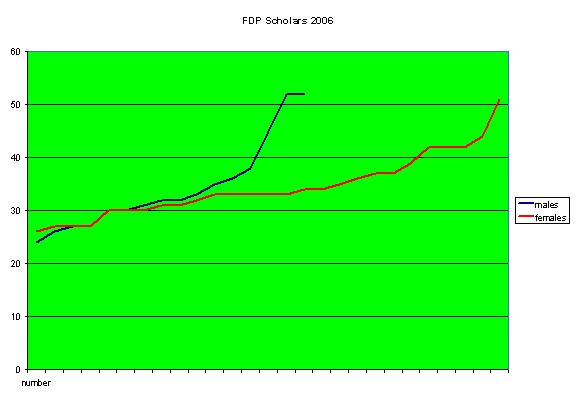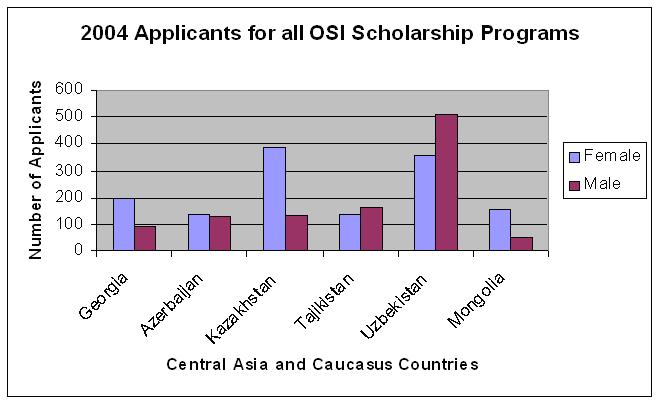Artur Tashmetov and Adrian Sherman (University of North Carolina, Wilmington)
“Gender Issues & International Scholar Mobility”
After comparising and analyzing the data of the last several years collected by international organizations (OSI, ACCELS/IREX, TEMPUS, Erasmus Mundus) regarding the development and spread of education in different parts of the world, it became apparent that there are some distinct gender differences in students leaving their home countries to study abroad. The disproportion between the male and female students that was confirmed also by the OSI data can give us not only a statistical understanding of the differences but also a deeper understanding of the processes that have been developing in those countries for the last several years.
 
(Data is for OSI Programs is from specific data report generated by OSI representatives. Contact: LStrashko@sorosny.orgfor additional information) This is one of the reasons why we should start to treat gender as an independent variable in the major data set in international education and make the access to that data easier. Because, whatever cross cultural aspect we study, we cannot avoid taking the gender issues into consideration as an influencing factor.
The major tendency in international mobility of scholars is represented by the following percentage distribution: approximately 65% of scholars are female and 35% of scholars are male. That distribution has been quite stable for the last several years.
We’ve isolated three major sub variables that affect the disproportion of gender distribution in international scholar mobility. These are age, sphere of scientific interest and country of origin. The data for the Fulbright Scholar Program from the Council for International Exchange of Scholars Annual Report (http://www.cies.org/download/2003AR.pdf) demonstrates that females prefer to go abroad in their early 20’s or after their 30’s while males start to participate in international education programs more actively in their late 20’s and early 30’s. We presume that it is related to child bearing.
Graphic (Data for the Fulbright Student Program is from specific data reports generated by the institute of International Education. Contact: Carol Tegen at ctegen@iie.org for additional information.


(Data is for OSI Programs is from specific data report generated by OSI representatives. Contact: LStrashko@sorosny.org for additional information)
The sphere of scientific interest is an undoubtedly influencing factor in the gender distribution for international scholars. The data from (ISA 2005) indicates that females prevail in Social Sciences and Humanities while male participants of educational programs still hold their position in such spheres as Mathematics, Informatics, Engineering and Technology. In the spheres of Business and the Sciences distribution is approximately even. (ISA 2005).

 Now, the most difficult sub variable to analyze is the country of origin of the participants. This issue presumes that the researcher is familiar with geopolitical and cultural specificities of the country. Only under these conditions can we make right interpretation in data change. For instance, data gotten from OSI shows a sharp rise of activity of females in program participation in Georgia and Kyrgyzstan, that is undoubtedly connected to recent political revolutions, and decrease of activity in Uzbekistan (actually it is true for both females and males) that is connected to the suppression of the democratic movement in the country.

 Generally, the data indicates that in Europe, Caucus and Central Asia the increase of liberalization of women and better political integration of a country into the world society results as stimulating factor for the more active participation of women in international programs. (Data is for OSI Programs is from specific data report generated by OSI representatives. Contact: LStrashko@sorosny.org for additional information). Another contributing factor is religion. In countries with strong religious orientations, males have a tendency to be more active in studying abroad.
In conclusion, we may assume that there are more variables that are factors affecting gender distribution in international programs, for example females learn foreign languages easier, they create social bonds more easily, and give each other social support more willingly and demonstrate higher level of discipline and pedantry in subject study. To avoid unnecessary speculations we need to create a data base in a way that will make it possible to easily extract such variables of gender as: age, country of origin, host country, language, training, length of study. If the access to such a database for interested researchers is provided it would greatly enhance their ability to understand the complexity of the issue.
Presentation in Power Point Format, 286 KB
| 


